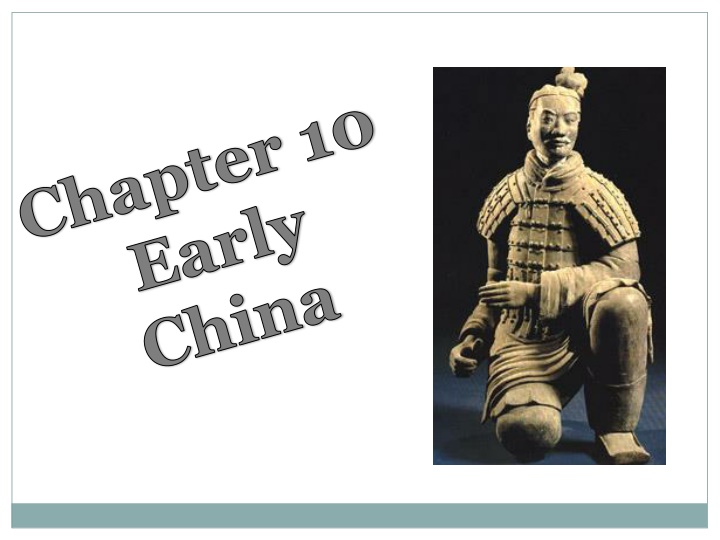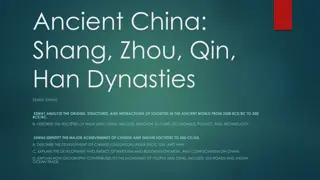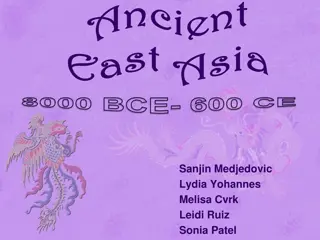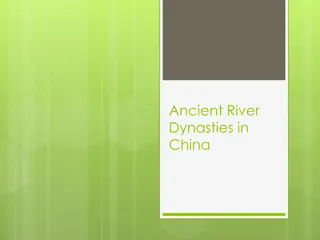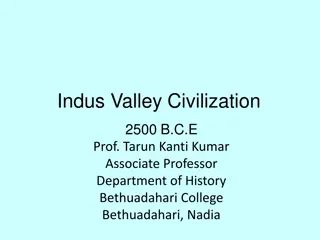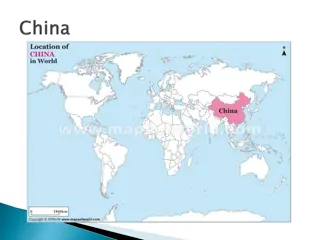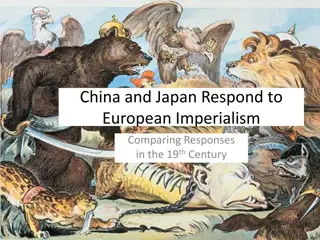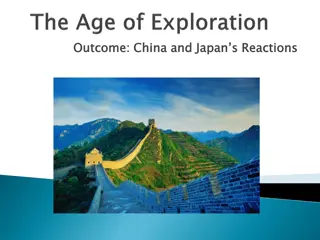Ancient China: Birth of Civilization and Shang Dynasty
People in ancient China settled along the Huang He and the Chang Jiang rivers, utilizing the fertile soil for agriculture. The region's geographic features, including mountains and deserts, limited interactions with other civilizations. Myths and legends surround the early history, with Y the Great said to have controlled flood waters and founded the Xia dynasty. The Shang dynasty, China's first, thrived from 1750 BC to 1045 BC, with the capital at Anyang and a focus on urban development and military strength.
Download Presentation

Please find below an Image/Link to download the presentation.
The content on the website is provided AS IS for your information and personal use only. It may not be sold, licensed, or shared on other websites without obtaining consent from the author.If you encounter any issues during the download, it is possible that the publisher has removed the file from their server.
You are allowed to download the files provided on this website for personal or commercial use, subject to the condition that they are used lawfully. All files are the property of their respective owners.
The content on the website is provided AS IS for your information and personal use only. It may not be sold, licensed, or shared on other websites without obtaining consent from the author.
E N D
Presentation Transcript
Chapter 10 Early China
10.1 The Birth of Chinese Civilization People in China first settled along the Huang He or the Yellow river. This river flows to the Pacific Ocean and provided early China with loess.
The rich soil helps farmers grow large amounts of food on small plots of land. As a result the Huang He valley emerged as one of the great wheat- producing areas of the ancient world. The Huang He has also often flooded and cost millions of lives. The Chinese call the Huang He China s Sorrow in honor of the people who have been killed by the floods.
Over time, the people of China moved south and settled near another great river the Chang Jiang or Yangtze River. This river is the longest in Asia and about 3,915 miles long! It was an important waterway for trade and transportation.
Mountains and deserts cover most of China so only 1/10th can be farmed. The mountains and deserts limit contact between China and other civilizations. East of the Tian Shan is a vast, rocky desert known as the Gobi. The Chinese called their land the Middle Kingdom and thought it was the center of the world.
Myths and Legends According to myths, Y the Great dug the firstchannelsto control the flood waters of the Huang He.
Legend has it that Y founded Chinas first dynasty. That dynasty was named Xia.
SHANG DYNASTY China s first Dynasty 1750 BC To 1045 BC
Archaeologists have unearthed long buried walls and buildings. These ruins show that the Shang built the first Chinese cities. The royal capitol was Anyang and the King was the political, religious, and military leader. They sent out large armies to defend the kingdoms boarders.
Warlords, are military leaders who lead their own armies, and ruled the territories that the king appointed. Shang kings relied on the warlords to govern local territories. Aristocrats, people of noble birth whose wealth came from the land they owned, passed their land and power to their children or younger family members.
Most Shang people were farmers. There were much smaller groups of merchants, artisans, and slaves. Farmers worked the land that belonged to the aristocrats.
The Shang honored their ancestors, or long dead family members. Today, the Chinese still pay respect to their ancestors by going to temples and burning small paper copies of food, clothing, and other items.
Early Chinese writing Used pictographs and ideographs
Chinese artists of the time made beautiful objects of bronze. They made vases and dishes from clay and carved statues from ivory and jade.
ZHOU: Chinas longest Dynasty
In 1045 B.C. rebels led by an aristocrat named Wu Wang overthrew the Shang government. Wu declared the new dynasty called the ZHOU The king led the government, ruling with the help of a bureaucracy which was made up of officials who carried out the tasks of the government. The Zhou king assigned loyal aristocrats to govern each of the territories. These positions were hereditary. This meant that when an aristocrat died, a son or another member of the family governed the territory
The Chinese believed their king represented them before the gods. Zhou kings claimed that kings ruled China because they had the Mandate of Heaven. Zhou kings claimed that the Mandate of Heaven gave them the right to rule.
The period from 400 B.C. to 200 B.C. is known as the Period of the Warring States. During this time, aristocrats ignored the king s commands and fought with each other.
